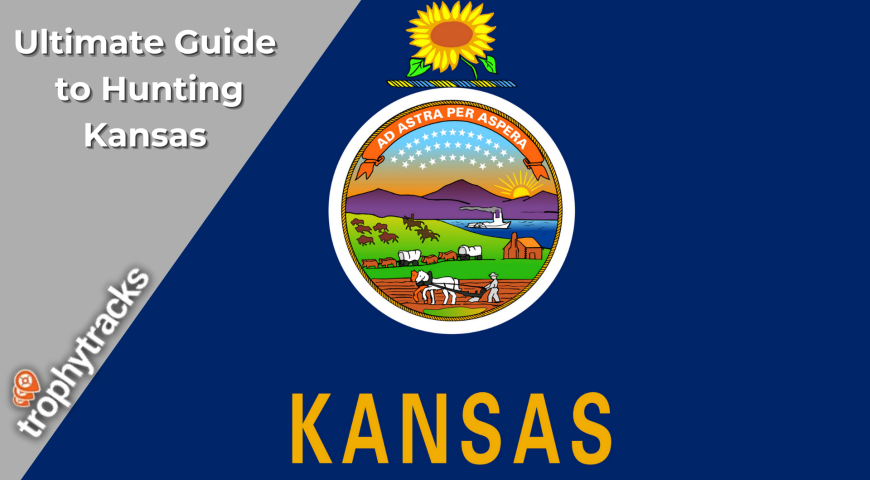
Trophy Tracks Guide to Kansas Turkey Hunting
The United States is full of top-tier hunting destinations that cater to just about any type of hunter.
Out of the 50 states, though, there a very few that compete with Kansas when it comes to the best turkey hunting America has to offer
The Sunflower State, or Kansas, is one of our country’s top destinations for turkey hunters, providing sportsmen with both stunning landscapes and thriving turkey populations. So, whether you’re just a beginner or a well-seasoned hunter, Kansas’ carefully managed wildlife and diverse habitats provide an absolutely perfect backdrop for a turkey hunt of a lifetime.
Due to Kansas being such a destination for Turkey, we decided to dive into just about everything you need to know about Kansas turkey hunting, so strap in and get ready to become an expert.
Turkey Species in Kansas
When it comes to turkey in Kansas, the state is home to two main turkey species:
The Rio Grande and Eastern Turkey.
Each of these types of birds offers their own unique challenges for turkey hunters. Understanding these differences and aspects like their habitats and behaviors is the key to a successful hunt.
Rio Grande Turkeys
First up is the Rio Grande turkey. These are primarily found in the western and central regions of Kansas and thrive in open grasslands and along riverbeds, where they forage for seeds, insects, and fruits.
Quite recognizable by their long legs and bronze-green feathers, Rio Grande turkeys are well-suited to the semi-arid environments of the Kansas plains. Thanks to their nomadic behavior, hunters often end up scouting extensively to locate them before taking any type of shot.
Eastern Turkeys
Next up are Eastern turkeys, who inhabit the eastern portion of Kansas where dense woodlands and mature forests provide cover and ample food sources.
These birds are much larger and more vibrant in coloration when compared to Rio Grande turkeys, with distinct white barring on their wings and tails. Eastern turkeys are also less migratory and often remain within a well-defined home range, making them both a challenging and rewarding target.
Hybrid Turkeys
In areas where the ranges of Rio Grande and Eastern turkeys tend to overlap, hybrids can sometimes occur. These mixed birds display a variety of mixed characteristics of both species and provide a unique trophy for hunters lucky enough to come across them.
Hunting Seasons and Dates
Kansas offers multiple turkey hunting seasons that are designed to accommodate different hunting styles and groups of hunters.
It is important to first recognize which group of hunters you fall into, and then identify which Kansas turkey hunting season applies to you and your party.
Youth and Disabled Season
The earliest season is for youth and disabled hunters. This season is an exclusive early-season opportunity for hunters aged 17 and younger or those with disabilities.
Scheduled from April 1 to April 15, this season reduces the competition in the field and helps to foster inclusivity in the hunting community.
This time frame opens up an excellent opportunity for beginners to experience the excitement of turkey hunting with fewer distractions and less competition.
Archery Season
Next up after youth and disabled in archery season. This runs concurrently with part of the youth and disabled season, spanning from April 7 to April 15.
This period is ideal (and specifically) designed for bowhunters who prefer a quieter, more methodical approach to hunting. With turkeys less pressured early in the season, archers often enjoy closer encounters and more enjoyable hunts in this early session.
Regular Firearm Season
Now for the regular season. The typical firearm season, which runs from April 16 to May 31, and as you can imagine, is the most popular hunting period.
Coinciding with the turkey breeding season, this allows hunters to use calling strategies to lure toms into range. The extended season length also offers some great flexibility, making it accessible for hunters with unfavorable schedules.
Laws and Regulations
Just as with any hunting in any nother state, adhering to Kansas hunting laws ensures the sustainability and survival of turkey populations and also promotes ethical hunting practices.
Understanding these regulations is another necessary step for all hunters preparing for a Kansas turkey hunt.
Permit Requirements
In Kansas, all hunters must possess a valid Spring Turkey Permit, which allows the harvest of one bearded turkey.
Permits are available for residents and non-residents, with discounted options for youth hunters. They can be purchased online or at authorized retailers statewide. Hunters born after July 1, 1957, must also complete a hunter education course before obtaining a Kansas license.
Bag Limits and Legal Methods
As we already mentioned, Kansas enforces a strict bag limit of one bearded turkey per season, which is necessary for proper population sustainability.
The legal methods of hunting turkey in Kansas include shotguns with specific shot sizes and archery equipment. Hunters must follow regulations regarding hunting hours as well, which run from one-half hour before sunrise to sunset, and hunters must also refrain from using bait or electronic calls.
Public and Private Land Access
Like in all states, hunters must secure permission before hunting on private property and familiarize themselves with rules for public hunting lands.
Kansas offers an extensive Walk-In Hunting Access (WIHA) program, allowing hunters to explore private lands enrolled in the program without prior permission.
Licensing and Permits
Making sure you have the proper licenses and permits is a pretty straightforward process but can vary depending on residency status and age.
Licensing Process
Kansas residents aged 16 to 74 are required to obtain a state hunting license and a Spring Turkey Permit.
On the other hand, non-residents are required to purchase a non-resident hunting license in addition to their turkey permit. Licenses can be obtained through the Kansas Department of Wildlife and Parks website or at licensed vendors.
Hunter Education Requirements
All hunters born after July 1, 1957looking to hunt in Kansas must complete a certified hunter education course.
These courses cover essential topics, including firearm and hunter safety, hunting ethics, and wildlife conservation, ensuring that participants are well-prepared for a safe and legal hunt.
Hunting Zones and Public Lands
Kansas is divided into multiple hunting units, each offering its own, unique opportunities and challenges.
As we hinted towards earlier, public lands and private hunting options expand access for hunters across the entire state.
Hunting Units
Kansas’ hunting units are organized to reflect habitat diversity and turkey population density.
Units in the central and western regions are dominated by Rio Grande turkeys, whereas Eastern turkeys are more abundant in the eastern zones.
Understanding the characteristics of each unit is important when it comes down to selecting the right location for the type of hunt you’re pursuing.
Public Hunting Areas
Kansas boasts one of the most extensive networks of public hunting areas, including state wildlife areas and lands enrolled in the WIHA program.
Popular areas include the Flint Hills, known for their scenic beauty and plentiful turkey populations, and the Smoky Hills, which offer a mix of open grasslands and wooded areas.
Hunting Techniques and Equipment
A successful Kansas turkey hunt requires a combination of strategy, skill, and the right hunting equipment.
Understanding turkey behavior in Kansas and investing in quality gear can significantly improve your chances or taking home that prized trophy turkey.
Calling Strategies
As any hunter knows, using turkey calls to mimic turkey vocalizations is one of the most effective ways to attract birds during the breeding season.
Box calls, slate calls, and diaphragm calls are commonly used to imitate yelps, clucks, and gobbles, drawing toms into range.
Camouflage and Gear
Proper camouflage is another important aspect of blending into Kansas’ varied terrain.
Hunters should wear clothing that matches their hunting environment, whether it’s open grasslands or dense forests.
When it comes to shotguns, tight chokes and turkey loads are recommended for firearm hunters, while bowhunters should use broadheads designed specifically for turkeys.
Safety Precautions
All hunters know that safety is paramount during any hunt.
Hunters should wear blaze orange when moving to or from hunting spots to remain visible to others. It is also good practice to confirm your target before taking a shot to avoid accidents and ensure an ethical harvest.
Guided Hunts and Outfitters
For hunters unfamiliar with Kansas terrain or new to turkey hunting, guided hunts provide valuable expertise and resources.
Reputable outfitters offer access to prime hunting areas not available to the public, experienced guides, and high-quality equipment.
Guided hunts are also a great way to learn advanced techniques and enjoy a stress-free Kansas hunting experience.
Conservation and Wildlife Management
Kansas’ thriving turkey populations are a testament to successful conservation and wildlife management operations.
Funds from hunting licenses and permits support habitat restoration, population monitoring, and education programs. Organizations like the National Wild Turkey Federation collaborate with the Kansas Department of Wildlife and Parks to ensure sustainable hunting practices and protect vital habitats.
Preparing for Your Hunt
Preparation is key to a successful turkey hunt. While we briefly covered hunting tips, there is a lot more that goes into preparation.
Scouting locations in advance helps to identify roosting sites and turkey travel routes. A comprehensive gear checklist, including calls, camouflage, and appropriate weapons, is also a good idea so that you’re ready for any situation. When it comes to peak hunting seasons, planning accommodations and traveling early is especially important.
Post-Hunt Considerations
After a successful hunt, proper field dressing and meat processing are always needed to preserve the quality of your turkey.
Kansas offers a good selection of local processors and taxidermists for hunters looking to prepare meat or preserve trophies.
Additionally, tagging and reporting your harvest to the Kansas Department of Wildlife and Parks helps their teams monitor turkey populations and inform future management decisions.
Closing Thoughts
Kansas offers one of the country’s most rewarding turkey hunting experiences, as any turkey hunter who has experienced Kanas can attest.
By understanding the species, laws, and techniques specific to the state, hunters can enjoy a safe and successful trip without any unjust concerns.
Just remember that responsible hunting practices and support for conservation efforts ensure that future generations can continue to experience the thrill of Kansas turkey hunting. Whether you’re a seasoned hunter or a newcomer, Kansas promises memories that will last a lifetime.

